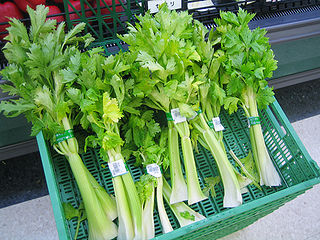
Celery is a cultivated plant in the family Apiaceae that has been used as a vegetable since ancient times. Celery has a long fibrous stalk tapering into leaves. Celery seed powder is used as a spice. Celeriac and leaf celery are different groups of cultivars of Apium graveolens.

The parsnip is a root vegetable closely related to carrot and parsley, all belonging to the flowering plant family Apiaceae. It is a biennial plant usually grown as an annual. Its long taproot has cream-colored skin and flesh, and, left in the ground to mature, becomes sweeter in flavor after winter frosts. In its first growing season, the plant has a rosette of pinnate, mid-green leaves. If unharvested, it produces a flowering stem topped by an umbel of small yellow flowers in its second growing season, later producing pale brown, flat, winged seeds. By this time, the stem has become woody, and the tap root inedible. Precautions should be taken when handling the stems and foliage, as parsnip sap can cause a skin rash or even blindness if exposed to sunlight after handling.

Celeriac, also called celery root, knob celery, and turnip-rooted celery, is a group of cultivars of Apium graveolens cultivated for their edible bulb-like hypocotyl, and shoots.
Plant species in the genus Allium known as wild garlic include the following:
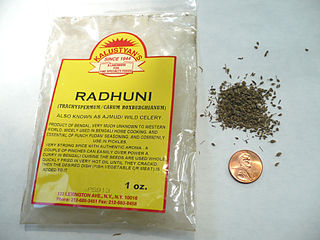
Trachyspermum roxburghianum is a flowering plant in the family Apiaceae. It is grown extensively in South Asia, Southeast Asia, and Indonesia. Its aromatic dried fruits, like those of its close relative ajwain, are often used in Bengali cuisine but are rarely used in the rest of India. It is also used as a spice in Bangladesh. The fresh leaves are used as an herb in Thailand and it is used medicinally in Myanmar and Sri Lanka.

Conopodium majus is a perennial herbaceous flowering plant in the celery family Apiaceae. Its underground part resembles a chestnut and is sometimes eaten as a wild or cultivated root vegetable. The plant has many English names variously including kippernut, cipernut, arnut, jarnut, hawknut, earth chestnut, groundnut, and earthnut. From its popularity with pigs come the names pignut, hognut, and more indirectly Saint Anthony's nut, for Anthony the Great or Anthony of Padua, both patron saints of swineherds.

Apium is a genus of about 20 species of flowering plants in the family Apiaceae, with a subcosmopolitan distribution in Europe, Asia, Africa, South America and Australia. They are medium to tall biennials or perennials growing up to 1 m high in the wet soil of marshes and salt marshes, and have pinnate to bipinnate leaves and small white flowers in compound umbels. Some species are edible, notably Apium graveolens, which includes the commercially important vegetables celery, celeriac and Chinese celery. Apium bermejoi from the island of Menorca is one of the rarest plants in Europe, with fewer than 100 individuals left.
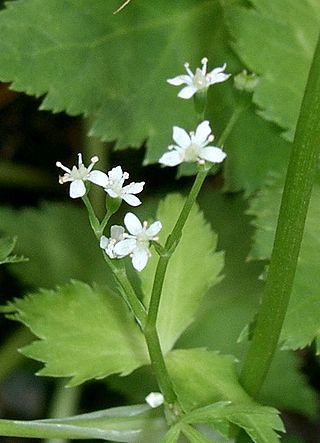
Cryptotaenia japonica, commonly called mitsuba, Japanese wild parsley and Japanese honewort among other names, is a herbaceous perennial plant in the celery family native to Japan, Korea and China. The plant is edible and is commonly used as a garnish and root vegetable in Japan, and other Asian countries. It is sometimes considered a subspecies of Cryptotaenia canadensis as Cryptotaenia canadensis subsp. japonica.

Smyrnium olusatrum, common name alexanders is an edible flowering plant of the family Apiaceae (Umbelliferae), which grows on waste ground and in hedges around the Mediterranean and Atlantic coastal regions of Europe. It was formerly widely grown as a pot herb, but is now appreciated mostly by foragers.

Ligusticum porteri, also known as oshá, wild parsnip, Porter’s Lovage or wild celery, is a perennial herb found in parts of the Rocky Mountains and northern New Mexico, especially in the southwestern United States.
Water celery is a common name for several plants and may refer to:

Vallisneria americana, commonly called wild celery, water-celery, tape grass, or eelgrass, is a plant in the family Hydrocharitaceae, the "tape-grasses". V. americana is a fresh water species that can tolerate salt, living in salinities varying from fresh water to 18 parts per thousand, although the limit to the salt tolerance is unclear, and is generally dependent on the duration and intensity of the plants’ exposure to the saline water. V. americana is a deep rooted plant with leaves, approximately one inch wide, with the ability to rise two or more meters above the clustered base of the plant. Contrary to the implications of one of its common names, wild celery bears little to no resemblance to the celery used as a vegetable. V. americana grows under water and is consumed by various animals, including the canvasback. The plants themselves are long, limp, flat, and have a green mid-ridge.

Lomatium californicum is a species of plant related to the carrot and the parsnip which is known by the common names California rock parsnip, celery weed, and California lomatium.
Wild parsnip is a common name for several plants and may refer to:
Indian celery is a common name for several plants and may refer to:
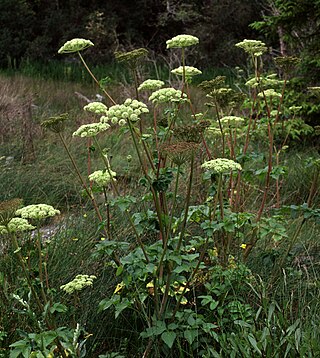
Angelica lucida is a species of angelica known by the common names seacoast angelica and sea-watch. It is also one of many species in the celery family which are casually called wild celery.

Cyclospermum leptophyllum is a species of plant in the family Apiaceae known by the common names marsh parsley, slender celery and fir-leaved celery; one source also mentions the name of wild cherry, although this may be a misspelling of "wild celery". This is a plant found worldwide at warm temperate to tropical latitudes and is considered a noxious weed in many areas. It is a taprooted branching herb reaching just over half a meter in height at maximum. It has threadlike green leaves a few centimeters long and small umbels of spherical flowers.

Celery mosaic virus (CeMV) is a plant pathogenic virus in the genus Potyvirus and the virus family Potyviridae .
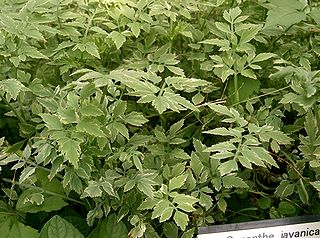
Oenanthe javanica, commonly Java waterdropwort, water celery, water dropwort, Chinese celery, Indian pennywort, minari and Japanese parsley, is a plant of the genus Oenanthe originating from East Asia. It has a widespread native distribution in temperate Asia and tropical Asia, and is also native to Queensland, Australia.














